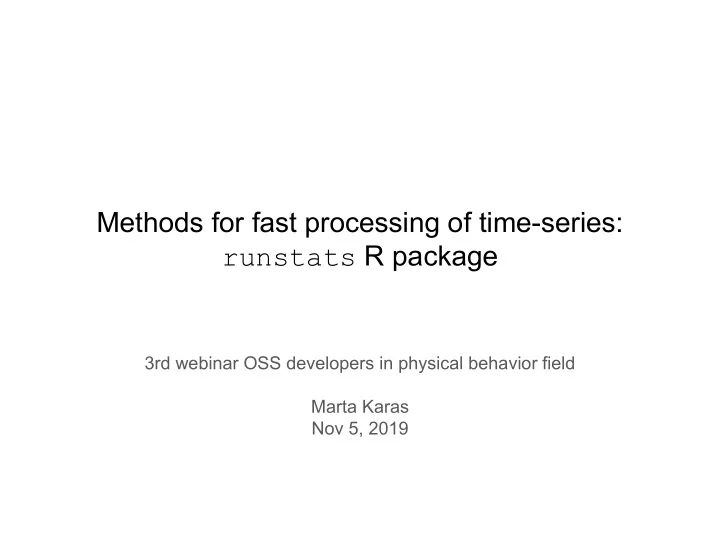

Methods for fast processing of time-series: runstats R package 3rd webinar OSS developers in physical behavior field Marta Karas Nov 5, 2019
Outline ● Fast time-series processing ○ Rolling statistics ○ Speed-up rolling mean/sd/var with 1-liner trick ○ Speed-up rolling cor/cov with convolution theorem ● runstats R package ○ CRAN: https://cran.r-project.org/web/packages/runstats/index.html ○ GitHub: https://github.com/martakarass/runstats (considered in this presentation*) *Commit link for package version used to generate results showed in this presentation.
Fast time-series processing: motivation Recall: raw accelerometry data is voluminous ● Example: raw accelerometry data collected from 1 patient, 1 week , frequency=100Hz yields 3 * 100 * 60 * 60 * 24 * 7 = 181,440,000 float values Some often used operations: ● Smoothing (e.g. running window average) ● Running variance, running correlation (with some short signal) must be done fast
Example 1: running window average (running mean) Input: vector x : len(x) = N (window length) scalar win_n Output: out[1] mean( ) out[2] mean( ) out[N-n+1] mean( )
Simple R is not fast: running window average ## Running window average of a time-series RunningMean.sapply <- function(x, win_n){ l_x <- length(x) sapply(1:(l_x - win_n + 1), function(i){ mean(x[i:(i + win_n - 1)]) }) } N <- 10000000 # 10,000,000 ~18h of fs=100Hz 1-dimensional time-series x <- runif(N) win_n <- 100 system.time({ RunningMean.sapply(x, win_n) }) # user system elapsed ~ 1.25 minute of execution # 75.880 3.545 79.678
Example 2: running correlation Input: vector x : len(x) = N vector y: len(y) = n, n<N Output: out[1] cor( , ) out[2] cor( , ) out[N-n+1] cor( , )
Simple R is not fast: running correlation ## Running covariance of long time-series x and short(er) y RunningCor.sapply <- function(x, y){ l_x <- length(x) l_y <- length(y) sapply(1:(l_x - l_y + 1), function(i){ cor(x[i:(i+l_y-1)], y) }) } N <- 10000000 # 10,000,000 ~18h of fs=100Hz 1-dimensional time-series n <- 100 x <- runif(N) y <- runif(n) system.time({ RunningCor.sapply(x, y) }) # user system elapsed ~ 8.5 minutes of execution # 516.994 2.554 519.946
Outline ● Fast time-series processing ○ Rolling statistics ○ Speed-up rolling mean/sd/var with 1-liner trick ○ Speed-up rolling cor/cov with convolution theorem ● runstats R package ○ CRAN: https://cran.r-project.org/web/packages/runstats/index.html ○ GitHub: https://github.com/martakarass/runstats (considered in this presentation)
1-liner trick implemented in runstats R package Goal: compute x vector running average over moving window of length W runningMean(x, W){ diff(c(0, cumsum(x)), lag = W) / W } Acknowledgement: this piece is the most recent improvement contributed by Lacey Etzkorn (PhD student at JHU Biostat); previously it had been previously implemented also via FFT.
runstats R package: running window average ## Running window average of a time-series RunningMean.sapply <- function(x, win_n){ l_x <- length(x) sapply(1:(l_x - win_n + 1), function(i){ mean(x[i:(i + win_n - 1)]) }) } ~18h of fs=100Hz 1-dimensional time-series N <- 10000000 # 10,000,000 x <- runif(N) win_n <- 100 system.time({ RunningMean.sapply(x, win_n) }) # user system elapsed ~ 1.25 minute of execution # 75.880 3.545 79.678 system.time({ runstats::RunningMean(x, win_n) }) # user system elapsed ~ 0.2 seconds of execution (~350x faster) # 0.216 0.019 0.237
Outline ● Fast time-series processing ○ Rolling statistics ○ Speed-up rolling mean/sd/var with 1-liner trick ○ Speed-up rolling cor/cov with convolution theorem ● runstats R package ○ CRAN: https://cran.r-project.org/web/packages/runstats/index.html ○ GitHub: https://github.com/martakarass/runstats (considered in this presentation)
Speed-up computing with convolution theorem [1/]
Speed-up computing with convolution theorem [2/]
Speed-up computing with convolution theorem [5/]
Convolution used in runstats R package Goal: compute rolling covariance between (longer) x and (shorter) y RunningCov(x, y){ # (...) covxy <- (conv(x, y) - W * meanx * meany)/(W - 1) }
Convolution used in runstats R package Goal: compute rolling covariance between (longer) x and (shorter) y RunningCov(x, y){ # (...) covxy <- (conv(x, y) - W * meanx * meany)/(W - 1) }
Convolution used in runstats R package Goal: compute rolling covariance between (longer) x and (shorter) y RunningCov(x, y){ # (...) covxy <- ( conv(x, y) - W * meanx * meany)/(W - 1) } convolution of (longer) x and (shorter) y (precomputed) rolling mean of x := "rolling product" of x and y
Convolution used in runstats R package Goal: compute rolling covariance between (longer) x and (shorter) y RunningCov(x, y){ # (...) covxy <- ( conv(x, y) - W * meanx * meany)/(W - 1) } convolution of (longer) x and (shorter) y (precomputed) rolling mean of x := "rolling product" of x and y
runstats R package: running correlation ## Running covariance of long time-series x and short(er) y RunningCor.sapply <- function(x, y){ l_x <- length(x) l_y <- length(y) sapply(1:(l_x - l_y + 1), function(i){ cor(x[i:(i+l_y-1)], y) }) } ~18h of fs=100Hz 1-dimensional time-series N <- 10000000 # 10,000,000 n <- 100 x <- runif(N) y <- runif(n) system.time({ RunningCor.sapply(x, y) }) # user system elapsed ~ 8.5 minutes of execution # 516.994 2.554 519.946 system.time({ runstats::RunningCor(x, y) }) # user system elapsed # 5.922 0.452 6.383 ~ 6 seconds of execution (~87x faster)
runstats R package Provides methods for fast computation of running sample statistics for a time-series. Implemented running sample statistics: ● mean , standard deviation , and variance over a fixed-length window of time-series, ● correlation , covariance , and Euclidean distance (L2 norm) between short-time pattern and time-series. CRAN index: https://cran.r-project.org/web/packages/runstats/index.html
runstats R package - a comparator example Dane Van Domelen (personal website) ● Former post doc in JHU Biostat ● Biostatistician at Karyopharm Therapeutics Inc ● Authored a bunch of interesting R packages ● R package dvmisc: Convenience Functions, Moving Window Statistics, and Graphics ○ includes sliding_cor , sliding_cov functions implemented in rcpp; very fast! Note: ● Implementation of convolution via convolution theorem + FFT is a general way that can be used to speed-up convolution in mostly any language (i.e. Python) ● Nearest future plans for runstats update: search for fastest FFT implementation I can plug to use in R (perhaps rcpp?)
Recommend
More recommend